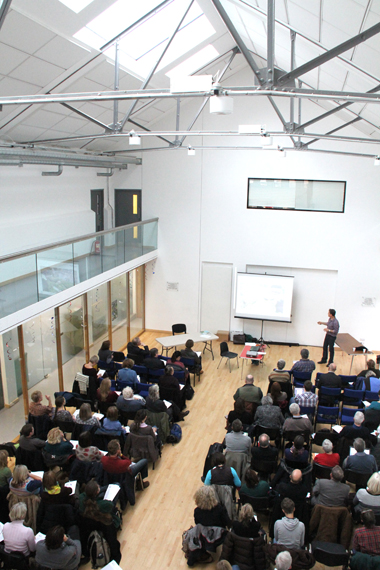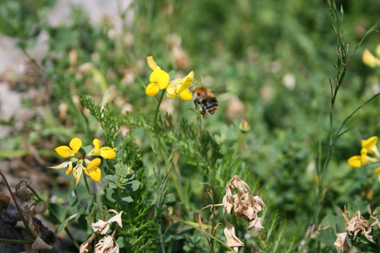For the second year running Mildmay Community Centre with its own wildflower green roofs played host for the Wildlife Gardening Forum Conference 2012. Justin was invited to talk on the process of creating a green roof for his own house, the Muse. It has become an oasis of wildlife with four beehives on the roof, nestled amongst flourishing native wildflowers, surrounded by the chatter of birds in the trees and young chicks in the nestboxes embedded in the walls; and all this in central London!
All the attendees sat happily throughout the day in the warmth of the centre; a certified Passive House, still without any heating so far this winter, with indoor temperatures still above 20 degrees centigrade. There was much discussion and networking alongside a number of splendid talks, with entirely organically produced refreshments provided by the nearby 'Mother Earth' wholefood store with community centre staff who made everyone feel very welcome. The warm and comfortable hall, easily seating 90, is available for hire at very reasonable rates - call the centre management on 020 7249 8286 or email tphillips@mildmaycp.org.uk.

The following is an account of the day by Dr Steve Head, The Wildlife Gardening Forum Coordinator.
Nearly 90 people attended the Wildlife Gardening Forum conference in the Mayville Community Centre, where the superb environmental management system allowed everyone to stay alert and excited through a long day. It was a very successful meeting, starting with three talks on green roofs, with Justin Bere leading the discussion on green roofs not only from an architect's perspective, but also revealing his personal passion for and excitement he has had from developing his own unique and ambitious approach to creating wildlife habitat on the roofs of his own house.
Dusty Gedge gave a revealing insight into the historical reasons why so many people specify a really boring and imported non-native Sedum roof. Green roofs are a technology which has come of age, and should become the default in the future. As Clare Dinham from Buglife showed, green roofs are already supporting exciting invertebrate species of conservation concern - "brown fields in the sky".
We were lucky enough to have attracted Dr Richard Miller Head of Sustainability for Government's Technology Strategy Board, to talk about the green infrastructure of future cities. Richard showed the massive challenges that population growth, abandonment of the countryside, and climate change are bringing to the world's cities. It was very reassuring to hear that Green Infrastructure - private and public gardens and green spaces - is seen as the key to making future cities fit for people to live in. This will require major conceptual shifts in planning, and raises concerns as to how - or if - it will be possible to retrofit green infrastructure to already blighted concrete jungles where property prices are colossal. After all, it was economically impossible NOT to redevelop the Twin Towers site in New York.
In the afternoon we had updates on the role of gardens for ponds, butterflies, and birds - especially looking at cats and their impact as unnatural predators. Cats evidently cause colossal mortality in small bird garden populations, but the evidence suggests they mainly catch the weedy birds that might not survive anyway, so they might not be quite as devastating as might previously have been feared.
In the long term, the most important part of the day may prove to have been the call for more engagement by Wildlife Gardening Forum Members, especially over contributing material for its new website. The forum is also looking for interested architects, planners and developers to work with the group to provide evidence and case studies for how better to manage urban space, and make sure new developments are wildlife-positive as well as environmentally sustainable. If you are interested contact Dr Steve Head, the Forum Coordinator, at wlgf@stephenmhead.com.
